
It should have been
a beautiful drive from Umbria into Tuscany — instead, the rain was
steady, and the countryside was hidden by mist and fog. We were getting
used to the dreary weather by now and longed for the sun of the Amalfi
Coast. Patience.
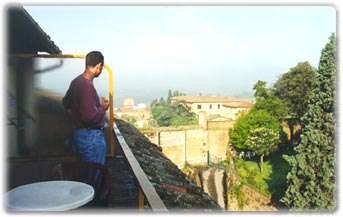 Our
next destination, Siena, was situated on three red clay hills (thus the
color "burnt sienna"). It prospered in the 13C-14C in art, trade
and banking, and had many battles with its rival, Firenze (Florence).
Then a devastating plague (the Black Death) hit in 1348 and that was the
end of the golden era.
Our
next destination, Siena, was situated on three red clay hills (thus the
color "burnt sienna"). It prospered in the 13C-14C in art, trade
and banking, and had many battles with its rival, Firenze (Florence).
Then a devastating plague (the Black Death) hit in 1348 and that was the
end of the golden era.
The Hotel Athena was close to the city center. And, as advertised, there was parking. What wasn't clear was that the "garage" was more a low-ceilinged cave-like space inside a wall along the street. Unique, and hard to maneuver in even with a small car. But it was convenient to the hotel: an elevator took us right into the lobby. It was a nice "character" hotel, we even had a small balcony (view).
So we set off again,
on foot, in the rain. Siena was similar to Perugia: a medieval hill city
with narrow, curved, cobblestoned streets (where cars and motorbikes would
whiz by, flattening you against walls) ... But unlike Perugia, Siena had
the magnificent Piazza del Duomo, with its striped marble campanile and
the Siena Cathedral. The cathedral facade, started in the 13th C by Giovanni
Pisano, is extremely ornate. The detail
is overwhelming. [Facade
panoramic] [Campanile
panoramic]
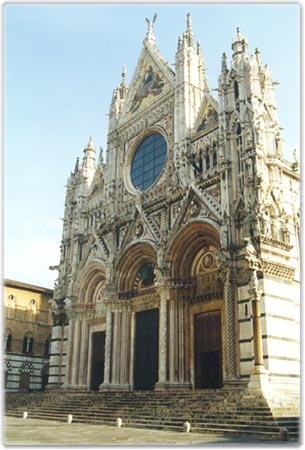 |
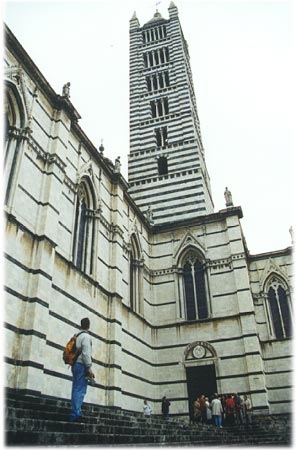 |
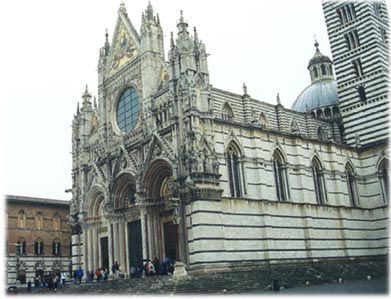 |
|
![]() Inside
the cathedral was no less impressive ... it's hard to convey how magnificent
it was. Soaring arches and columns, marble panels, decorated wooden stalls,
frescoes by Pinturicchio; beautiful,
rich colors throughout. And most spectacular was the octagonal pulpit (1266-68)
by Nicola Pisano where he carved seven panels showing
the life of Christ.
Photographs weren't allowed in the cathedral, though many people were
taking them. I snuck in a couple.
Inside
the cathedral was no less impressive ... it's hard to convey how magnificent
it was. Soaring arches and columns, marble panels, decorated wooden stalls,
frescoes by Pinturicchio; beautiful,
rich colors throughout. And most spectacular was the octagonal pulpit (1266-68)
by Nicola Pisano where he carved seven panels showing
the life of Christ.
Photographs weren't allowed in the cathedral, though many people were
taking them. I snuck in a couple.
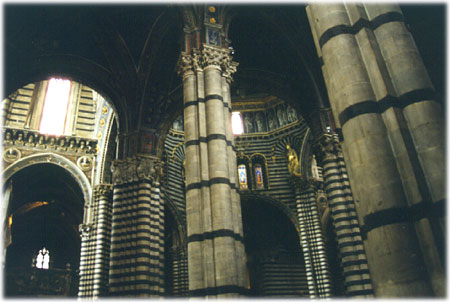 Black and white marble stripes inside too ... |
 Busts of popes along the cathedral walls |
Next stop was the Piazza del Campo ... it's a huge brick "square" in the center of Siena that's more of a fan shape, and slopes downward from its border to the Palazzo Pubblico tower and facade [Palazzo panoramic]. I included an overhead view (from a postcard) because it's hard to take in from ground level.
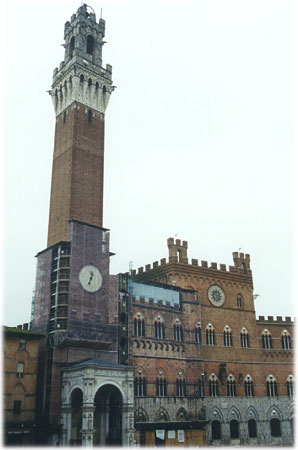 Palazzo Pubblico |
 Piazza del Campo (from a postcard) |
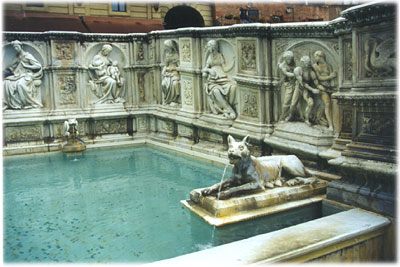 Fonte Gaia |
Twice a year the Palio
delle Contrade, a medieval festival, is held on the Piazza. The festivities
include a medieval ![]() costumed
procession and a bareback horse race around the outside loop of the Piazza.
People are packed in the center, and all around, to watch. It must liven
up the area greatly, which felt barren to me on first impression. Maybe
the space was too large and open, with no greenery. The only decorative
element is the Fonte Gaia, a copy of Jacopo della Quercia's fountain of
1348. [Fonte
panoramic]
costumed
procession and a bareback horse race around the outside loop of the Piazza.
People are packed in the center, and all around, to watch. It must liven
up the area greatly, which felt barren to me on first impression. Maybe
the space was too large and open, with no greenery. The only decorative
element is the Fonte Gaia, a copy of Jacopo della Quercia's fountain of
1348. [Fonte
panoramic]
The sun was back the next morning and Siena and the Tuscan hills glistened. We took an early morning walk back to the Duomo, and it was wonderfully free of crowds; in fact we were briefly alone in front of the cathedral. And we were the first ones in the Museo dell'Opera Metropolitana — by design — yes, we had this tourist in Italy thing down pretty well.
The Museo had a impressive entry hall lined with statues by Giovanni Pisano, and upstairs was Duccio's famous Maestà painting (1311), done in the same severe style we saw in Perugia. This Madonna and child surrounded by a heavenly court is considered the most precious work of the Middle Ages. There were many 17th C velvet tapestries upstairs, and a small door. This led to a narrow stairwell that went to the top of the unfinished cathedral facade. It's like an open, narrow "bridge" across the courtyard below. Siena and the countryside were beautiful from on high. [Duomo panoramic]
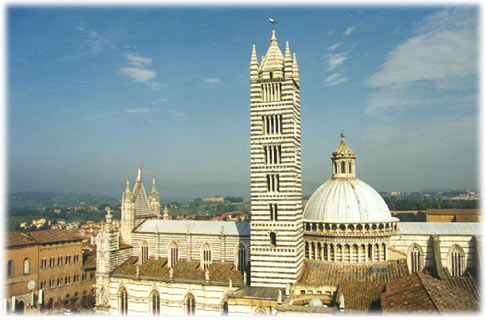 |
|
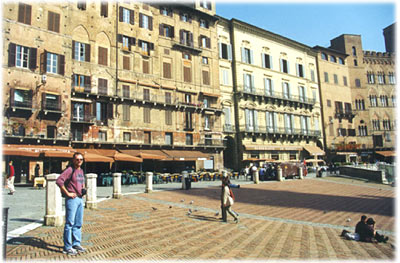 Peter at the Piazza del Campo |
 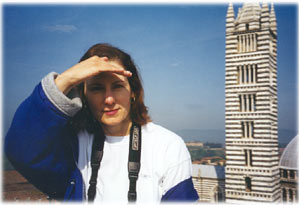 From the facciatone (unfinished facade), top & below |
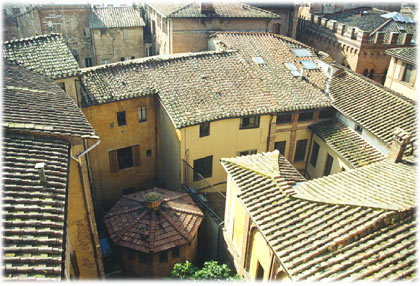 |
|
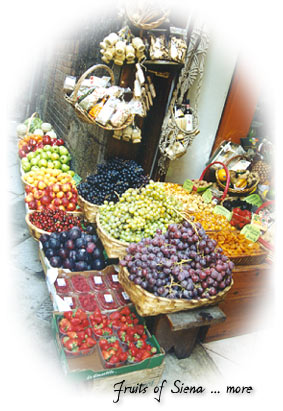 We
took another walk to the Piazza, this time enjoying it in the morning
sun ... And as we walked the streets and alleys, I was better able to
appreciate the vignettes
of Siena, so many of them.
We
took another walk to the Piazza, this time enjoying it in the morning
sun ... And as we walked the streets and alleys, I was better able to
appreciate the vignettes
of Siena, so many of them.
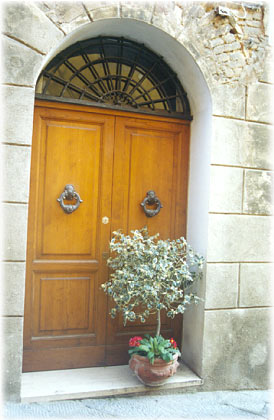 Then
it was time to hit the road — I was absolutely itching to get out
in the Tuscan countryside on this long-anticipated sunny day. It took
some doing to maneuver ourselves out of the Sienna city "limits,"
but once we were — wow. Tuscany was rolling hills of green and gold
and lines of sculpted cypress trees; it was luscious. [Toscana
slide show]
Then
it was time to hit the road — I was absolutely itching to get out
in the Tuscan countryside on this long-anticipated sunny day. It took
some doing to maneuver ourselves out of the Sienna city "limits,"
but once we were — wow. Tuscany was rolling hills of green and gold
and lines of sculpted cypress trees; it was luscious. [Toscana
slide show]
Olive groves and vineyards follow the flow of the terrain. Some of the best wine in Italy comes from the Chianti region of central Tuscany. There were historic structures scattered everywhere: villas, castles, churches, farmhouses. And many hilltop towns — with fortification walls built to protect them against the violence of the medieval period.
![]() San
Gimignano, one of the neatest hill towns, is known for its belle torri
— fine towers — there are 14 of them left today, of the 76 that
once stood. Hard to believe there were that many in such a small area.
These were private fortresses of wealthy residents. We walked the streets
[San
Gimignano slide show] and found great shops full of leather
goods, ceramics, art, jewelry and food. There were two main piazzas that
are surrounded by the towers and historic public buildings and churches.
We passed one of several butcher shops with the standard stuffed boar
at the entrance. A group of Italian schoolboys were amused by the boar
and starting making joking gestures and comments around it. The shop keeper
came out, scolding, and chased them off. The boys took it in stride, laughing
as they moved on.
San
Gimignano, one of the neatest hill towns, is known for its belle torri
— fine towers — there are 14 of them left today, of the 76 that
once stood. Hard to believe there were that many in such a small area.
These were private fortresses of wealthy residents. We walked the streets
[San
Gimignano slide show] and found great shops full of leather
goods, ceramics, art, jewelry and food. There were two main piazzas that
are surrounded by the towers and historic public buildings and churches.
We passed one of several butcher shops with the standard stuffed boar
at the entrance. A group of Italian schoolboys were amused by the boar
and starting making joking gestures and comments around it. The shop keeper
came out, scolding, and chased them off. The boys took it in stride, laughing
as they moved on.
Of course, both Perugia and Siena gave you a back-in-time feeling, but San Gimignano even more so. Because it was smaller in area and population, the streets and alleys very narrow (with fewer people on the periphery) and surrounded by Tuscan countryside, it was very personal, charming — I loved it. We were only there a short time, and didn't visit any museos or churches ... it was a day to be in the fresh air and warm light.
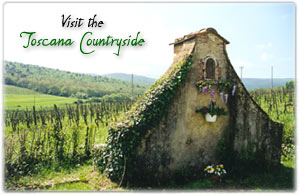 |
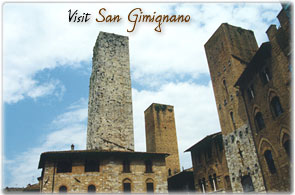 |
We took a roundabout route back to Siena, taking in as much of central Tuscany as we could. The next morning we were ready to head for our last destination (yes, this trip does end) ... Firenze.
Back
to Italy main
Roma • Roma2
• Roma3 • Vesuvio
& Pompei • Sorrento to Amalfi Coast
• Capri
Amalfi Coast • Perugia • Siena
& Toscana • Firenze • Firenze2
© 2001 CCarnovale Home | Web Design | Graphics | Photos | Travels